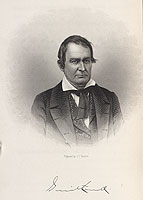![]()
Autographs for freedom. edited by Julia Griffiths. Auburn: Alden, Beardsley
& Co.; Rochester: Wanzer, Beardsley & Co., 1854.
![]()
Gerrit Smith
![]()
Gerrit Smith (1797-1874) was a wealthy abolitionist from Utica, New York.
His conversion to abolitionism occurred in 1835, when he attended an abolitionist
conference in Utica, New York. The meeting was disrupted by a violent
mob of anti-abolitionists. Consequently, Smith offered his Peterboro,
New York estate to house the conference and, there, made a powerful speech
on behalf of the cause. He became the president of the New York Anti-Slavery
Society for three years. Smith served as Station Master of the Underground
railroad and sold portions of his land to fugitive slaves for the nominal
fee of one dollar. Gerrit Smith was also one of the Secret Six, a group
of supporters who gave financial assistance to John Brown for his raid
at Harper’s Ferry. Smith ran for president three times and was the only
abolitionist to hold a Congressional office.
![]()
- William Lloyd Garrison
- Wendell Phillips
- Lydia Maria Child
- Samuel J. May
- Lucretia Mott
- Sojourner Truth
- Lewis Tappan
- William Seward
- Frederick Douglass
- Gerrit Smith
- Pennsylvania Hall
| |
| |
| |
| |
| |
| |
| |
| |
| |
| |
| |
| |

Copyright © 2002 Division
of Rare & Manuscript Collections
2B Carl A. Kroch Library, Cornell University, Ithaca, NY, 14853
Phone Number: (607) 255-3530. Fax Number: (607) 255-9524
For reference questions, send mail to:
rareref@cornell.edu
For questions or comments about the site, send mail to: webmaster.
